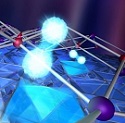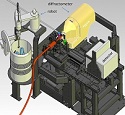Vol. 15, No. 4 - November 2014
View the Archives

Science Highlight
Antibody Recognition of the Influenza Hemagglutinin by Receptor Mimicry – Contacts: Yoshikazu Kurosawa, Fujita Health University and Ian A. Wilson, The Scripps Research Institute Influenza viruses infect millions of people each year, cause severe illness, and present a significant health challenge. Vaccines are effective in preventing the flu but they require almost yearly reformulation to keep up with the constantly changing viruses. The highly variable hemagglutinin (HA), the major surface glycoprotein on influenza viruses, binds host cells to initiate infection. Scientists have identified a broadly neutralizing antibody, F045-092, that can inhibit this binding. Read more... More ScienceStudy at SSRL Explains Atomic Action in High-Temperature Superconductors – Results Are First to Suggest How to Engineer Even Warmer Superconductors with Atom-by-Atom Control Excerpted from November 12, 2014 SLAC News Feature A team led by SSRL, SLAC Photon Science and Stanford University researchers explains why a thin layer of iron selenide superconducts at much higher temperatures when placed atop strontium titanate. These findings, described in the journal Nature, open a new chapter in the 30-year quest to develop superconductors that operate at room temperature, which could revolutionize society by making virtually everything that runs on electricity much more efficient. In this study, based on high-resolution angle-resolved photoemission spectroscopy measurements, the scientists concluded that interfacial coupling assists superconductivity in opening the energy gap for the process to take place at higher temperatures. Read more… Robotics Meet X-ray Lasers in Cutting-edge Biology Studies – Platform Brings Speed, Precision in Determining 3-D Structure of Challenging Biological Molecules Excerpted from November 21, 2014 SLAC News Feature A new goniometer-based setup for macromolecular crystallography that combines approaches developed within the Structural Molecular Biology program at SSRL with the unique beams at the Linac Coherent Light Source (LCLS) was described in the October 31 edition of the Proceedings of the National Academy of Sciences USA. The new platform, used as a non-permanent setup at the XPP station at LCLS, and pursued in collaboration with LCLS staff, provides an automated way to position individual crystals, rapidly and accurately, in the LCLS x-ray laser pulses. Read more… AnnouncementsNew SLAC Access and Badging ProceduresThe SSRL user access and badging procedures were changed as of October 1, 2014. Badges are now issued at the SLAC Security Office Building 235 by the SLAC main gate. There are additional requirements that need to be met for user to get access to the site and the SSRL beam lines for scheduled experiments. Please see: A step-by-step outline is provided below: Before traveling to SLAC, please list all experimenters who will participate in your scheduled experiments on proposals and beam time/support requests and inform your colleagues about access changes so that everyone coming onsite completes the following steps: 1. Register through the user portal to provide or update contact information. 2. Contact URA for additional requirements for users from certain countries. 3. Ensure that you have an appropriate business visa (e.g., B1/WB Business, not B2/WT Tourist). 4. Review updated SSRL user arrival & check-in procedures. 5. Complete all safety training (including Traffic Safety Course 154). 6. Stop at the Security Office Building 235 to obtain a new ID badge and/or proximity access. Bring identification to verify citizenship. 7. Prior to entering the experimental area or starting any experiments, check in with User Check-In Coordinator Jackie Kerlegan in the URA office in SSRL Building 120, Room 211 (Monday-Friday 7 am - 12 noon and 1 - 4 pm (except holidays)). 8. Contact the URA team for questions or assistance (650-926-2079/2087/3191). DOE Office of Science User Experiment Database The U.S. Department of Energy Office of Science (SC), which is the primary sponsor of SSRL operations, has recently announced that it will require that a limited set of information related to user research proposals be transmitted to SC annually. A subset of this information, including user name, institutional affiliation(s), and proposal title(s), will be publically disseminated at the conclusion of each fiscal year as part of an SC user facility user experiments database on the SC website. We encourage all SSRL users to assist us in providing the most up-to-date information for this SC data base by taking the following steps: Please log in to the user portal to review/revise your user profile to ensure that your institution and contact information are current. If you wish revise your proposal title(s), which will now be listed on the DOE's public website, please contact us. Upcoming Workshops and ConferencesLCLS-II Workshop, February 9-13, 2015, at SLAC National Accelerator Laboratory The LCLS is organizing three separate workshops from February 9-13, 2015 to advance the science case and refine the technical requirements for the LCLS-II X-ray free electron laser project. Each of the workshops will focus on a broad scientific area: Materials Physics, Life Sciences and Chemistry. This suite of workshops is a seminal event for the LCLS-II project, forming a cornerstone of the science strategy for ongoing LCLS developments and the transition to LCLS-II operations. The workshops are intended to gather together this information for critical review, modification and extension. Participants will be engaged in a structured set of discussions and debates to help define the most compelling future path for LCLS-II scientific exploitation. These sessions will cover all aspects of the future LCLS-II capabilities, from source parameters, through to end-station configurations, and detector and sample delivery requirements – both for near–term operations and longer–term development options. The results of these workshops will feed directly into a new science strategy for LCLS, and will help guide the design, commissioning and ultimate operation of the upgraded facility. SSRL management encourages everyone interested in applying LCLS-II to his or her scientific problems to attend. Separate registration is required for each of the three workshops, but the registration is free. For more information on each workshop including: invited speakers, preliminary schedule and registration please visit the workshops website. 12th International Conference on Synchrotron Radiation Instrumentation, July 6-10, 2015, New York City, NY 16th International Conference on X-ray Absorption Fine Structure (XAFS16), August 23-28, 2015, Karlsruhe Institute of Technology Karlsruhe, Germany 12th International Conference on Biology and Synchrotron Radiation (BSR) is being planned to take place in Menlo Park, CA on August 22-24, 2016. Save the Date. User Research Administration
The Stanford Synchrotron Radiation Lightsource (SSRL) is a third-generation light source producing extremely bright x-rays for basic and applied research. SSRL attracts and supports scientists from around the world who use its state-of-the-art capabilities to make discoveries that benefit society. SSRL, a U.S. DOE Office of Science national user facility, is a Directorate of SLAC National Accelerator Laboratory, operated by Stanford University for the U.S. Department of Energy Office of Science. The SSRL Structural Molecular Biology Program is supported by the DOE Office of Biological and Environmental Research, and by the National Institutes of Health, National Institute of General Medical Sciences. For more information about SSRL science, operations and schedules, visit http://www-ssrl.slac.stanford.edu. To unsubscribe from SSRL Headlines, just send an e-mail to listserv@ssrl.slac.stanford.edu with "signoff ssrl-headlines" in the body. To subscribe, send an e-mail to listserv@ssrl.slac.stanford.edu with "subscribe ssrl-headlines" in the body. Questions? Comments? Contact Lisa Dunn
|



